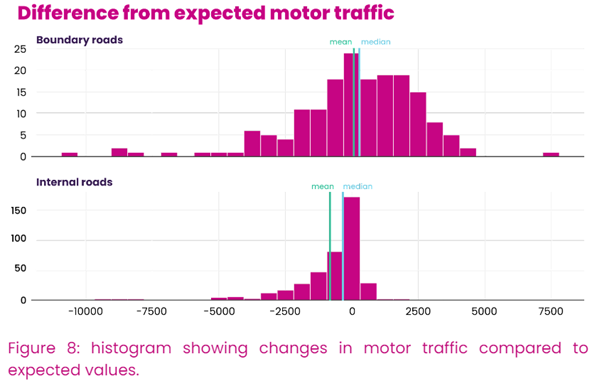The Interim report for Haringey Bounds Green LTN has been published – and whilst we’re used to the spin, this could be the most shocking example yet.
The overwhelming evidence shows the LTN is failing badly, and yet the report brazenly tries to pretend otherwise. 🧵(1)
The overwhelming evidence shows the LTN is failing badly, and yet the report brazenly tries to pretend otherwise. 🧵(1)
First of all boundary roads - the key point here, as always, is that these are already the most congested, polluted roads, with most schools, high occupancy dwellings, public transport access, most collisions and they're being made worse. (2)




And it's vital to add that the baseline for these (Nov 21) was itself based on increased traffic on boundary roads caused by the Enfield Bowes LTN, so these increases on boundary roads are actually cumulative and the full impact of the LTNs should be added to those shown here:(3) 

(Whilst we're focussing on Bowes + Bounds Green, as an aside it's worth mentioning the same applies on Boundary Rds in H/gey's other two LTNs which show some huge increases - further strengthening the case that this is a massive issue in many LTNs.) (4)








Moving on to one of the key justifications for introducing LTNs - to encourage active travel.
The data shows cylcing in and around the LTN is DOWN ... by 22% overall. (5)


The data shows cylcing in and around the LTN is DOWN ... by 22% overall. (5)


What does the report say about this? It rules out wider baseline factors (e.g. weather) but fails to consider that the LTN is causing the decline, even though, as we'll show later, 3x more residents say the LTN discourages cycling v encourages it - see 11 (6) 

What about road safety? As we've already pointed out, any plan to tackle road safety should start on main roads as that's where nearly all accidents are.
Nevertheless, LTNs are supposed to reduce speeding - yet in Bounds Green it's INCREASED on boundary AND internal roads: (7)


Nevertheless, LTNs are supposed to reduce speeding - yet in Bounds Green it's INCREASED on boundary AND internal roads: (7)


Further damning evidence that Bounds Green LTN is not working comes from the levels of support - look at the before and after - from 56% to 75% opposed, with lower support and almost all neutrals now negative. (8)




It's also worth noting solid opposition amongst the young (16-24) and those most likely to work and shop in Haringey, and the most likely to support = over 70s and those not working or shopping Haringey. (9)
Negatives outweigh positives in every possible area - but look at just how bad things seem to be on the boundary roads: (10)




Overall, the main areas of objection are all supported by the evidence in the report and the appendices
(NB 1600 pages worth - presumably the hope being that this will deter scrutiny). (13)
(NB 1600 pages worth - presumably the hope being that this will deter scrutiny). (13)

Perhaps most shocking of all: there is not a single meaningful consideration of possible disproportionate or discriminatory impact. Nothing at all in the EqIAs, no attempt to use census data to analyse actual LTN impact, yet the issue is well proven. (14)
enfielddispatch.co.uk/ethnic-dispari…
enfielddispatch.co.uk/ethnic-dispari…
So here we are again - further clearcut evidence of counter productive, negative impact. All ignored with the clear intention of blundering on regardless. Either the aims are not really what they claim them to be, or it's blinkered incompetence on a steggering scale. (15)
Report here:
minutes.haringey.gov.uk/documents/b294…
minutes.haringey.gov.uk/documents/b294…
Appendices here:
minutes.haringey.gov.uk/documents/b294…
minutes.haringey.gov.uk/documents/b294…
• • •
Missing some Tweet in this thread? You can try to
force a refresh

 Read on Twitter
Read on Twitter



















